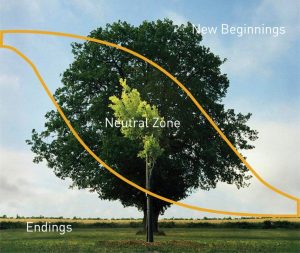Most people are quite uncomfortable with change; the reasons why people detest any change are explicable. People resist a change or oppose it out rightly. That’s the reason why it is important to understand importance of feelings as change proceeds, and why they need to be guided through it. William Bridges’ Transition Model is a helpful framework in change management.
While most people expect changes are meant to be positive. A lot depends on individuals how they make things better, easier, and to fast-track the route to success. In organizations sometimes the hard-working employees end up being the number one obstacle to a new initiative. Bridges’ transition model helps dealing with the people-aspect of change management. It helps in turning them from obstacles to supporters. As an organizational consultant, William Bridges found that the most important responsibility was of guiding people through transition for successful change. He identified three stages of transition and his model strives to help business leaders to understand the feelings people go through a change process.
Bridges highlights the difference between transition and change. Change is speedy, and people often have no say when it happens. But transition is a slower process that happens internally. Transition is what goes on inside people’s minds as they go through a change process. Employees get affected by change when it transits from one stage to the next. Therefore, business leaders must change their approach to people management in an empathetic development. The three stages of Bridges’ Transition Model are as follows:
Ending, losing, and letting go: When people first learn that they will have to face a change and their ‘comfort zone’ will be disturbed, they experience an emotional upsurge. If organizations fail to understand and acknowledge this fact, their employees might resist change all the way through a change initiative. When people see a change coming their way they feel afraid, they tend to rebuff, they feel angry, they feel disorientated, frustrated. And in short, they experience insecurity. Dealing with these feelings requires patience. People must be encouraged to be open about their emotional reaction to change and be understood by their superiors and peers about the way they feel. Throughout the change process discussions must be going on so that employees take initiatives on their own.
Employees must be told what their role will be, what their prospects would be the emoluments, the reporting relationship, their future growth in organization everything should be discussed with them. Bridges believed that the emotional reaction to change is most important to be handled. Emotional health and wellbeing is something that shouldn’t be discarded.
The Neutral Zone: In this stage people are confused and puzzled; they are not sure if the change is good, bad or ugly. They feel uncertain and irritated. It all depends on how nicely managers administer the change process. Employees struggle with their new workloads and new tasks. Each person experiences the change differently depending upon his capacity. This phase is like a flyover between the old and the new. People take time to get detached from the old style, in this stage they try to adapt to the new. People experience resentment towards the change initiative. They are lost in their own world trying to cope with change. Their morale is low and therefore the productivity is also low. Employees carry anxiety about their role, status and identity.
Factually this stage can be one to initiate creativity, innovation, and renewal. This is a great time to encourage people to try new ways of thinking, practicing and working.
Employees must be guided by managers with patience. Their guidance is incredible, it is very important as people go through this neutral period. This can be an uncomfortable time, because it can seem unproductive, and in this little progress is being made. Frequent meetings and sharing feedback is a good solution. When people enter the neutral zone, they are not yet entirely comfortable with change and will still need a lot of encouragement.
The New Beginning: After a while, after few days pass things seem to start falling into place. People start seeing the real results of the change process. They might or might not see the positive result. Employees see how their efforts are starting to pay off. Suddenly, it all makes sense to them. The emotions are positive. They feel energized, they want to learn more, and they feel committed to their role. Naturally, this state of affairs should be sustained as the working atmosphere is positive. This is a time for celebration and rewards coming in pocket.
But, sometimes people can still slip back into stage 2 – the neutral zone. The results cannot be taken for granted, therefore it still necessary for managers to be vigilant.
Strength of the model: This framework focuses on transition, not change. The difference between these is subtle but important. Change is something that happens to people, even if they don’t agree with it. Transition, on the other hand, is an internal process, it happens in our minds. Change can happen very quickly, whereas transition usually is a slow process.
Changes occur in our lives at regular intervals, whether we are aware of them or not. As part of our nature as humans, we normally do not like major changes and the fear of the unknown that accompanies change. Some changes paralyze us emotionally. To handle changes in our life, we need to accept that we need to internally strengthen ourselves. And, we all need guidance and mentoring at each stage.














































